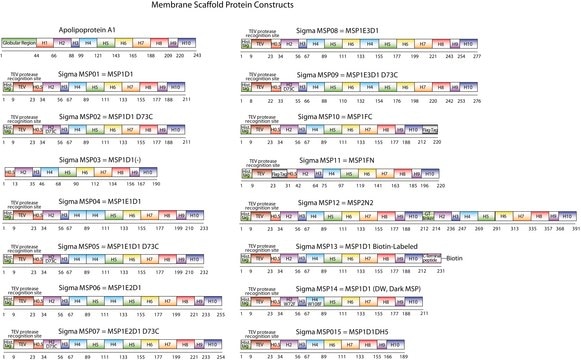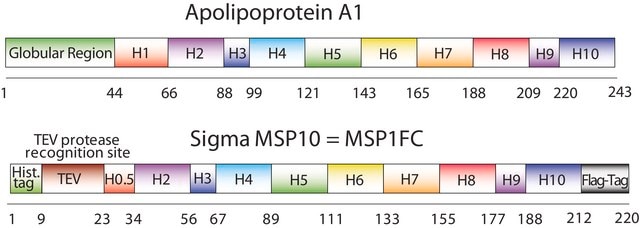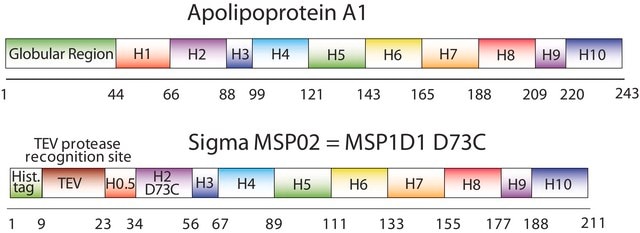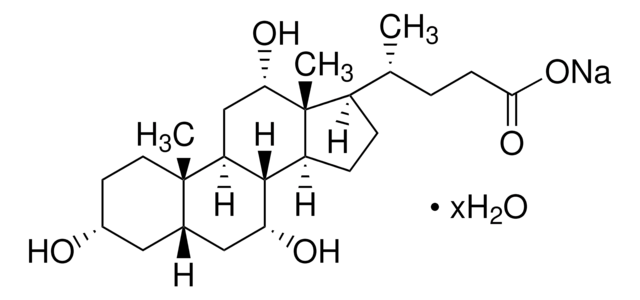MSP01
Membrane Scaffold Protein 1D1
recombinant, expressed in E. coli, buffered aqueous solution
Synonym(s):
Membrane Scaffold Protein 1D1, MSP1D1, MSP1T2
Sign Into View Organizational & Contract Pricing
All Photos(4)
About This Item
UNSPSC Code:
12352200
Recommended Products
recombinant
expressed in E. coli
Quality Level
assay
≥90% (SDS-GE)
form
buffered aqueous solution
shipped in
ambient
storage temp.
−20°C
Looking for similar products? Visit Product Comparison Guide
General description
Nanodiscs are non-covalent structures that contain a phospholipid bilayer and a membrane scaffold protein (MSP), a genetically engineered protein, which mimics the function of Apolipoprotein A-1 (ApoA-1). The first MSP, MSP1, was engineered with its sequence based on the sequence of A-1, but without the globular N-terminal domain of native A-1. The Membrane Scaffold Protein 1D1 (MSP1D1) variant of MSP1 deletes the first 11 amino acids in the Helix 1 portion (referred to as “H0.5” in the accompanying figure) of the original MSP1 sequence.
Application
Nanodisc soluble lipid bilayer systems have proven to be a widely applicable means for rendering membrane proteins soluble in aqueous solutions in a native-like bilayer environment where they remain monodisperse and active. The critical component of nanodiscs is the encircling amphipathic helical protein belt (membrane scaffold protein).
The nanodisc system has been employed to incorporate a wide variety of proteins including GPCRs, P450s, bacteriorhodopsin, coagulation factors, cholera toxin, TAR receptor and aromatase.
For guidelines on the use of this and other MSP′s to prepare Nanodiscs, please visit our Protocols for Membrane Scaffold Proteins and Nanodisc Formation page.
Biochem/physiol Actions
Generates Nanodiscs ~9.7 nm in diameter
Legal Information
Nanodisc technology, and many of its uses, are covered by the following patents held by the University of Illinois.
- 7,691,414 Membrane scaffold proteins
- 7,662,410 Membrane scaffold proteins and embedded membrane proteins
- 7,622,437 Tissue factor compositions and methods
- 7,592,008 Membrane scaffold proteins
- 7,575,763 Membrane scaffold proteins and tethered membrane proteins
- 7,083,958 Membrane scaffold proteins
- 7,048,949 Membrane scaffold proteins
Nanodisc technology, and many of its uses, are covered by the following patents held by the University of Illinois.
- 7,691,414 Membrane scaffold proteins
- 7,662,410 Membrane scaffold proteins and embedded membrane proteins
- 7,622,437 Tissue factor compositions and methods
- 7,592,008 Membrane scaffold proteins
- 7,575,763 Membrane scaffold proteins and tethered membrane proteins
- 7,083,958 Membrane scaffold proteins
- 7,048,949 Membrane scaffold proteins
Storage Class
10 - Combustible liquids
wgk_germany
WGK 2
flash_point_f
Not applicable
flash_point_c
Not applicable
Certificates of Analysis (COA)
Search for Certificates of Analysis (COA) by entering the products Lot/Batch Number. Lot and Batch Numbers can be found on a product’s label following the words ‘Lot’ or ‘Batch’.
Already Own This Product?
Find documentation for the products that you have recently purchased in the Document Library.
Customers Also Viewed
Christopher I Cazzonelli et al.
eLife, 9 (2020-02-01)
Carotenoids are a core plastid component and yet their regulatory function during plastid biogenesis remains enigmatic. A unique carotenoid biosynthesis mutant, carotenoid chloroplast regulation 2 (ccr2), that has no prolamellar body (PLB) and normal PROTOCHLOROPHYLLIDE OXIDOREDUCTASE (POR) levels, was used
Benjamin J Cole et al.
PLoS biology, 15(9), e2002860-e2002860 (2017-09-25)
Diverse soil-resident bacteria can contribute to plant growth and health, but the molecular mechanisms enabling them to effectively colonize their plant hosts remain poorly understood. We used randomly barcoded transposon mutagenesis sequencing (RB-TnSeq) in Pseudomonas simiae, a model root-colonizing bacterium
Yan Bao et al.
Autophagy, 14(9), 1562-1573 (2018-06-27)
Macroautophagy/autophagy is a conserved process in eukaryotes that contributes to cell survival in response to stress. Previously, we found that endoplasmic reticulum (ER) stress induces autophagy in plants via a pathway dependent upon AT5G24360/IRE1B (INOSITOL REQUIRING 1-1), an ER membrane-anchored
Ping Wang et al.
Autophagy, 16(1), 123-139 (2019-03-27)
Autophagy is a conserved catabolic process in eukaryotes that contributes to cell survival in response to multiple stresses and is important for organism fitness. In Arabidopsis thaliana, the core machinery of autophagy is well defined, but its transcriptional regulation is
Our team of scientists has experience in all areas of research including Life Science, Material Science, Chemical Synthesis, Chromatography, Analytical and many others.
Contact Technical Service












